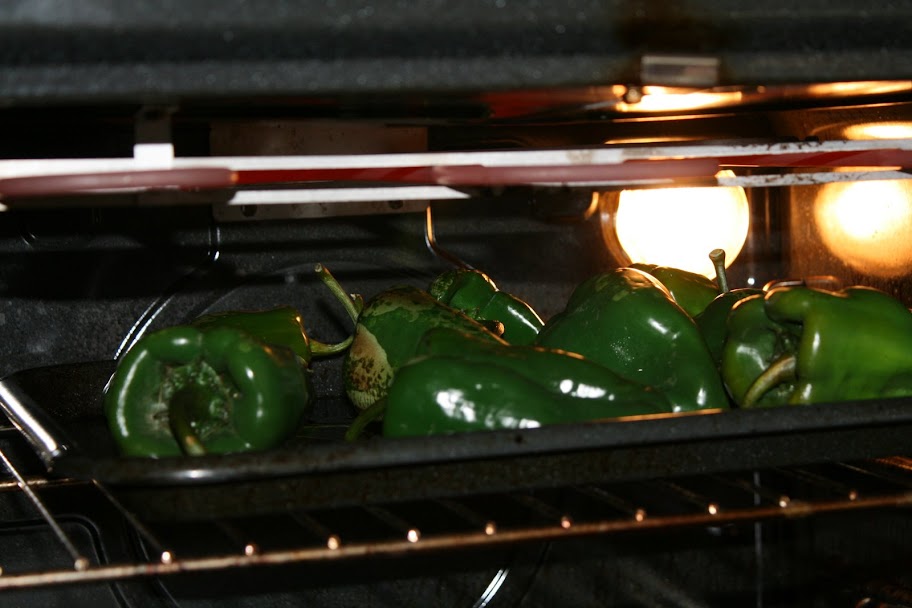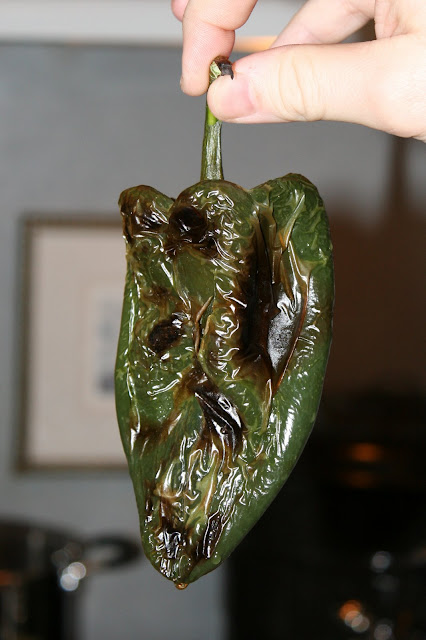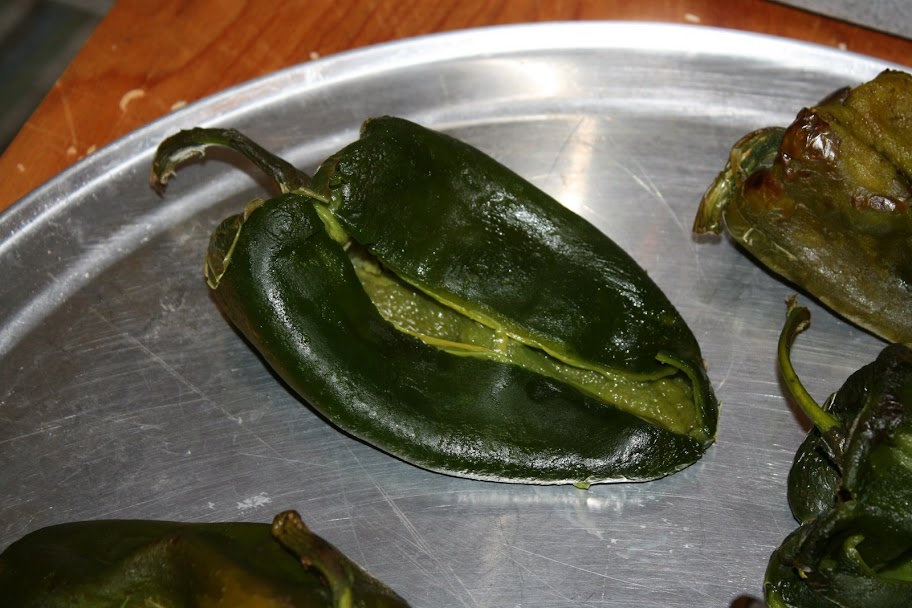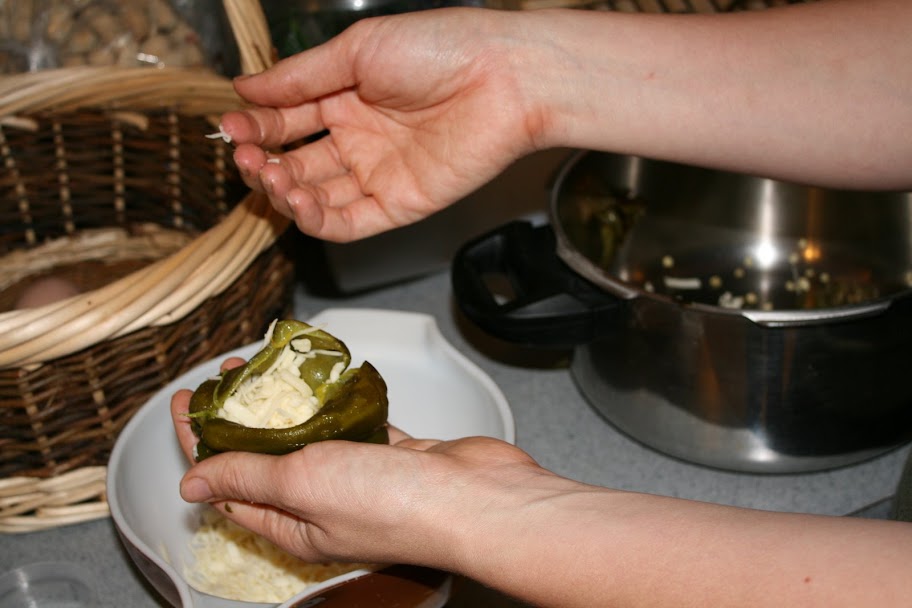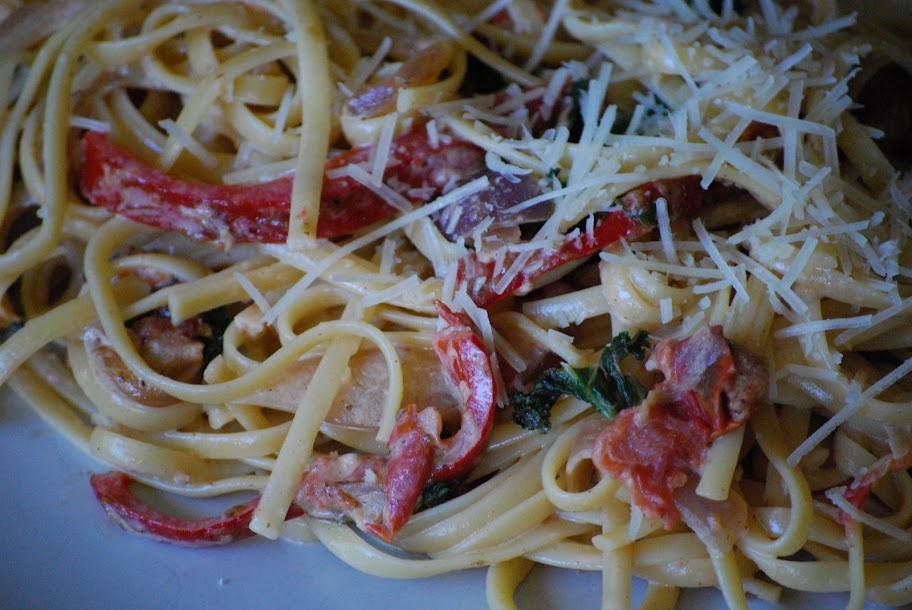
Sunday, December 14, 2008
Cold market day... hot root vegetables.

Monday, October 27, 2008
Pasta E Fagioli
1 lb mild Italian sausage
1 28oz can of stewed tomato with basil (Mur Glen has the perfect ones)
1 can of white butter beans
1 can of dark kidney beans
1 HEAD of garlic, skins off and chopped fine
1/2 lg onion, diced
1/2 green pepper, diced
28oz water (just fill the tomato can)
1 Tbs oregano
1 tsp marjoram
1 tsp tarragon
2 Tbs basil
Brown Italian sausage. Add diced onion, green pepper, and garlic and saute until onion starts to clear. Add can of tomatoes and water. Bring to a boil. Add beans, and all spices. Stir for 1 minute. Put a lid on the pan and let boil on Med for about 10 minutes or when the spices are not all sitting on top of the soup.
Serve with good bread and salad. It is the best soup I have ever tasted.
PUMPKIN PIE!
 Our pumpkin patch field trip was Friday. Now my kids are FULLY in the spirit of the season. We don't do the freaky Halloween stuff. No decapitated heads hanging from our doorway, or dead people coming up from a patch of soil in the front yard. No sir. I hate that part of Halloween, and frankly, don't understand it. There is enough terror and nasty war going on in this world to create a time to romanticize it. But I do love Halloween. Black cats, spider webs covered with dew, turning leaves, jack-o-lanterns, candle light, dark evenings, being something that you are not normally for a day. I just love the season.
Our pumpkin patch field trip was Friday. Now my kids are FULLY in the spirit of the season. We don't do the freaky Halloween stuff. No decapitated heads hanging from our doorway, or dead people coming up from a patch of soil in the front yard. No sir. I hate that part of Halloween, and frankly, don't understand it. There is enough terror and nasty war going on in this world to create a time to romanticize it. But I do love Halloween. Black cats, spider webs covered with dew, turning leaves, jack-o-lanterns, candle light, dark evenings, being something that you are not normally for a day. I just love the season. Monday, October 13, 2008
Leek and Sausage Pasta


I made these with Cyan Saturday morning. They are this recipe, with WW flour instead of Spelt this time and put into muffin tins. Notice they are on sweet little red flower plates that I found for $.40 a peice at Goodwill. They don't totally match my bowls, but I really liked the compliment... so they are here to stay. And even if they were not, the whole set cost me less than a Pumpkin Spice Latte. Gotta love buying used.
Saturday, October 11, 2008
Vegan Lunchbox
 What a great book. Whether you are vegan, or going in that direction, or a total carnivore, this book is a great one to have on hand. Great recipes, good ideas, all sorts of good.
What a great book. Whether you are vegan, or going in that direction, or a total carnivore, this book is a great one to have on hand. Great recipes, good ideas, all sorts of good. Friday, October 3, 2008
Inspiration
Monday, September 15, 2008
Market Work
 Working the market has been interesting. People in Seattle are dedicated enough to eating organic that they just don’t think about the price… but wow. Our stuff is SPENDY. $2.50/lb for potatoes (damned good potatoes which are COMPLETELY worth it, but until you spend the money to try them, who would know?) $1.50/lb for the biggest cauliflower you have ever seen (and they are pretty and delicious too) but that means spending $6 for a cauliflower that is three times bigger than you really wanted, and then of course, $4/lb for the best green beans and peas you have ever tasted. What it means to be beyond organic is pretty amazing. The industrial organics can sell the ¼ of their stock (which are probably the ones that don’t quite fit into the mainstream idea of what the veggie is supposed to look like….) And they sell them to soup companies that want to claim ‘organic’ and still have plenty for every single whole sale order they have. We don’t have that luxury. We have to sell the 5lbers, right along with the 2lbers that we know everyone will buy.
Working the market has been interesting. People in Seattle are dedicated enough to eating organic that they just don’t think about the price… but wow. Our stuff is SPENDY. $2.50/lb for potatoes (damned good potatoes which are COMPLETELY worth it, but until you spend the money to try them, who would know?) $1.50/lb for the biggest cauliflower you have ever seen (and they are pretty and delicious too) but that means spending $6 for a cauliflower that is three times bigger than you really wanted, and then of course, $4/lb for the best green beans and peas you have ever tasted. What it means to be beyond organic is pretty amazing. The industrial organics can sell the ¼ of their stock (which are probably the ones that don’t quite fit into the mainstream idea of what the veggie is supposed to look like….) And they sell them to soup companies that want to claim ‘organic’ and still have plenty for every single whole sale order they have. We don’t have that luxury. We have to sell the 5lbers, right along with the 2lbers that we know everyone will buy.Anyway… it has been interesting.
 Yesterday I came home with a big box of food from the farm. I had one huge cauliflower, a 2lb bag of green sugar snap peas, 5 cukes, two bunches leeks, 5 onions, 4lbs potatoes, a bunch of carrots, a bunch of red chard, two tiny romenesca, two bunches cilantro, one bunch dill, one bunch mint, and a half lb wild Chantalle mushrooms. At the end of the day, the guy next door to us at the market traded for two half pints of fresh local ice cream, (one of which will be gracing my kids bellies after lunch), another neighbor traded for some bone broth for me and some fresh cows cream cheese which Hannah took home. And yet another neighbor traded for pastries for a snack. And on top of all of that, I got sent home with an entire case of sunflowers that we had left over, and wouldn't last until the Tuesday Market, which Cyan graced all of our neighbors with bouquets before we ate dinner.
Yesterday I came home with a big box of food from the farm. I had one huge cauliflower, a 2lb bag of green sugar snap peas, 5 cukes, two bunches leeks, 5 onions, 4lbs potatoes, a bunch of carrots, a bunch of red chard, two tiny romenesca, two bunches cilantro, one bunch dill, one bunch mint, and a half lb wild Chantalle mushrooms. At the end of the day, the guy next door to us at the market traded for two half pints of fresh local ice cream, (one of which will be gracing my kids bellies after lunch), another neighbor traded for some bone broth for me and some fresh cows cream cheese which Hannah took home. And yet another neighbor traded for pastries for a snack. And on top of all of that, I got sent home with an entire case of sunflowers that we had left over, and wouldn't last until the Tuesday Market, which Cyan graced all of our neighbors with bouquets before we ate dinner.


Saturday, September 13, 2008
Local Living can be easy
 It isn't always. But in September, local living is easy. Farmers markets are packed to the brim with ways to get everything you need, from fish, veggies and fruits for dinner, to toys for Christmas, and flowers for your dining room table, along with other necessities like soap and fresh baked bread. The amount of local bounty I see go past my stand every Sunday just amazes me! I got a lot of my things local before. But I had no idea how much was out there, processed or grown within 200 miles of my house is everything I need from home baked pies to fresh peanuts from just over the mountains.
It isn't always. But in September, local living is easy. Farmers markets are packed to the brim with ways to get everything you need, from fish, veggies and fruits for dinner, to toys for Christmas, and flowers for your dining room table, along with other necessities like soap and fresh baked bread. The amount of local bounty I see go past my stand every Sunday just amazes me! I got a lot of my things local before. But I had no idea how much was out there, processed or grown within 200 miles of my house is everything I need from home baked pies to fresh peanuts from just over the mountains.The above is not 100% local. The organic, single ingredient pasta that I have come to depend on for my husbands dietary 'needs' comes from Italy... and the balsamic vinaigrette came from California, but the rest? The goat cheese, the tomatoes (my gardens only real produce this year), and the beautiful golden beets from the farm are all amazingly from within 40 miles of my house.
Sweet and Tangy Pasta Salad
1/4 lb golden beets (red beets will do, but I don't like the way they stain everything pink)
1 lb tomatoes (plum or cherry work best)
2/3 cup balsamic vinaigrette dressing (I use Paul Newman's)
4 oz soft goat cheese
1 lb rotini pasta (WW would work well here)
Directions:
Cook pasta until al dente. Drain and douse with cold water reduce sticking.
Steam beets until fork tender. Slice tomatoes into bite sizes.
Add in the cheese and dressing, saving veggies for last. Toss with veggies (feel free to add others too! Baby spinach would be good tossed in, as would a host of other greens).
Eat cold.
Serves 4
~~~~~~~~~~~~~~~~~~~~~~~~~~~~~~~~~~~~~
A surprise in the garden! You remember that volunteer pumpkin that I was ranting about a few months ago? Well, it looks like we may actually get two jack-o-lantern pumpkins out of it!

 Gardening is always a journey.
Gardening is always a journey.Wednesday, September 10, 2008
In Defence of Food by Micheal Pollan
 I am becoming a die hard Michael Pollan fan. He is a wonderful writer (as most journalists are), but the information he gives answers SO many questions!
I am becoming a die hard Michael Pollan fan. He is a wonderful writer (as most journalists are), but the information he gives answers SO many questions! Wednesday, August 27, 2008
Chili Rellenos
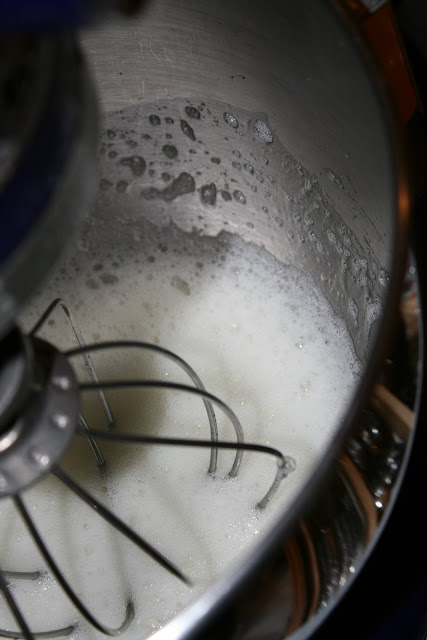
While I was peeling the peppers, I whipped the egg whites.
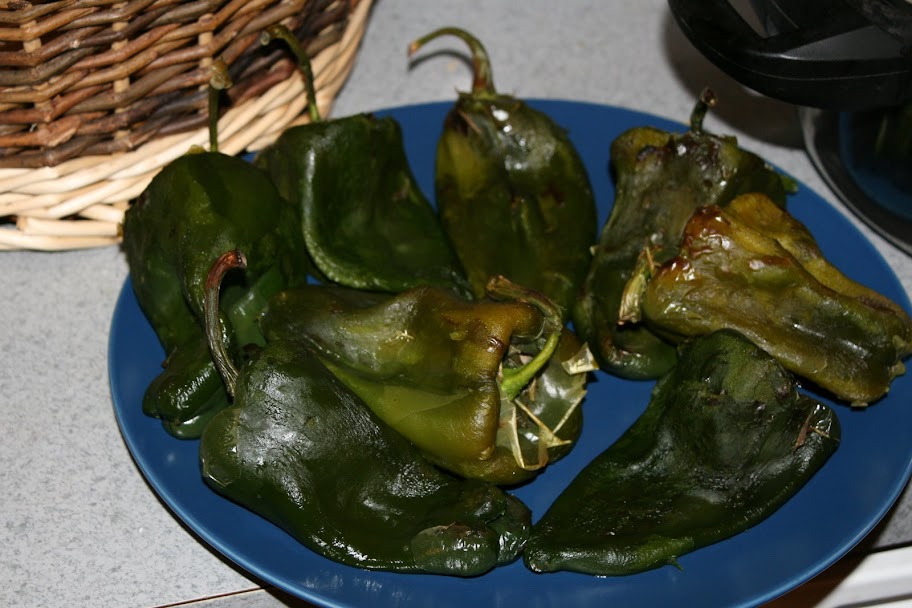
Peeled peppers.

Egg yolks, whipped.

And a token bad pic of me, but I look happy. So I will leave it in the line.
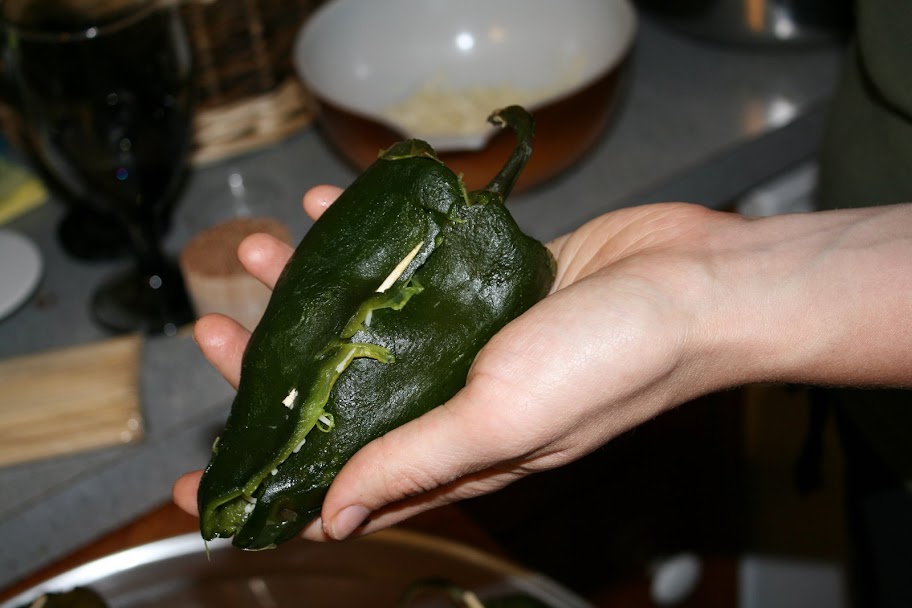
I used a toothpick to keep the peppers together after stuffing.
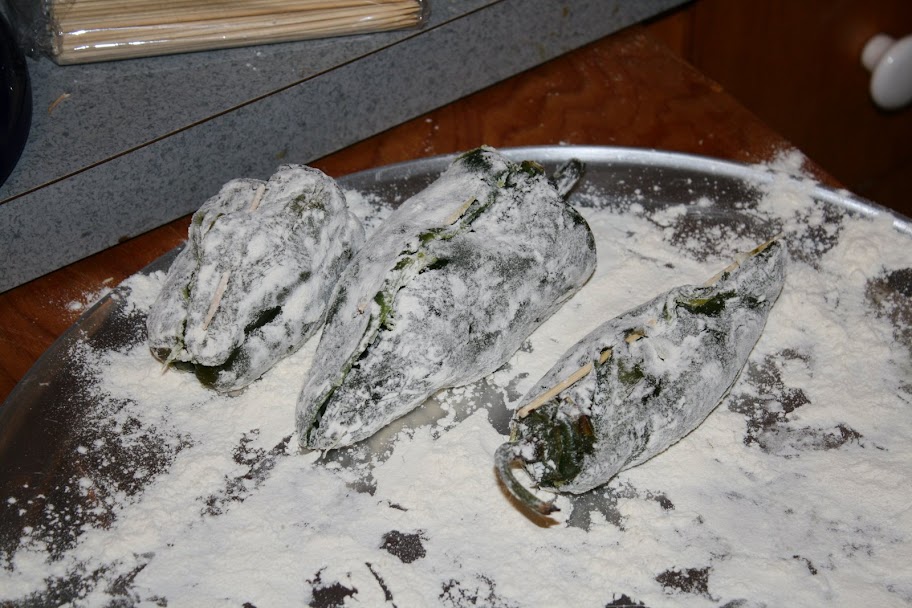
Floured and ready to be battered.
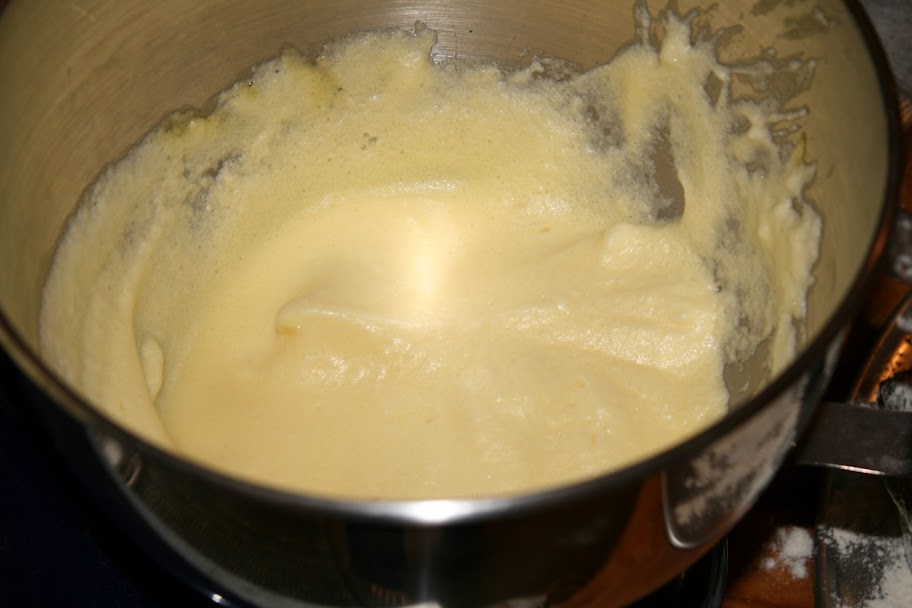
Mixed fluffy egg whites and beaten egg yolks.
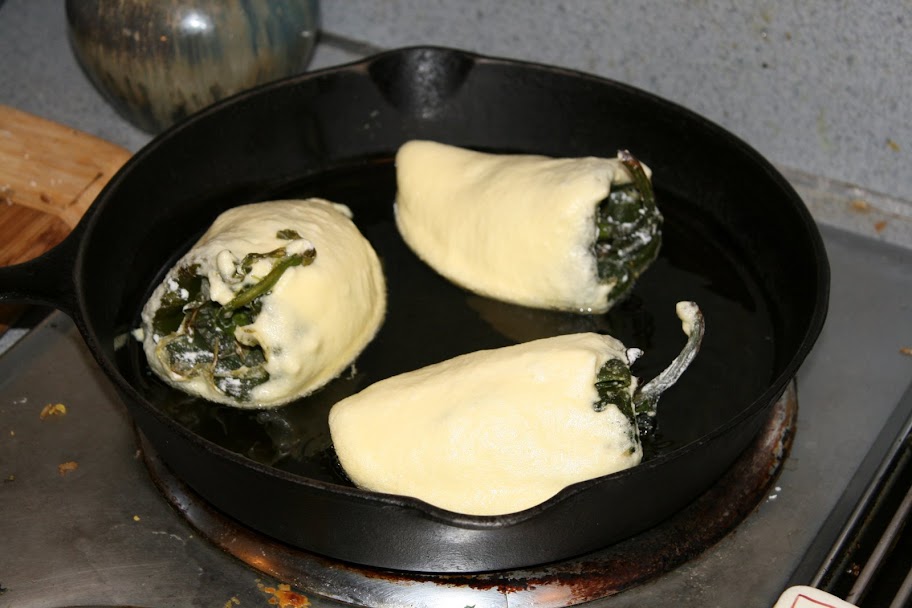
Dipped in the batter and placed in a 1/4 inch of olive oil (I know that olive oil isn't really authentic, but it was in lieu of lard or canola oil).
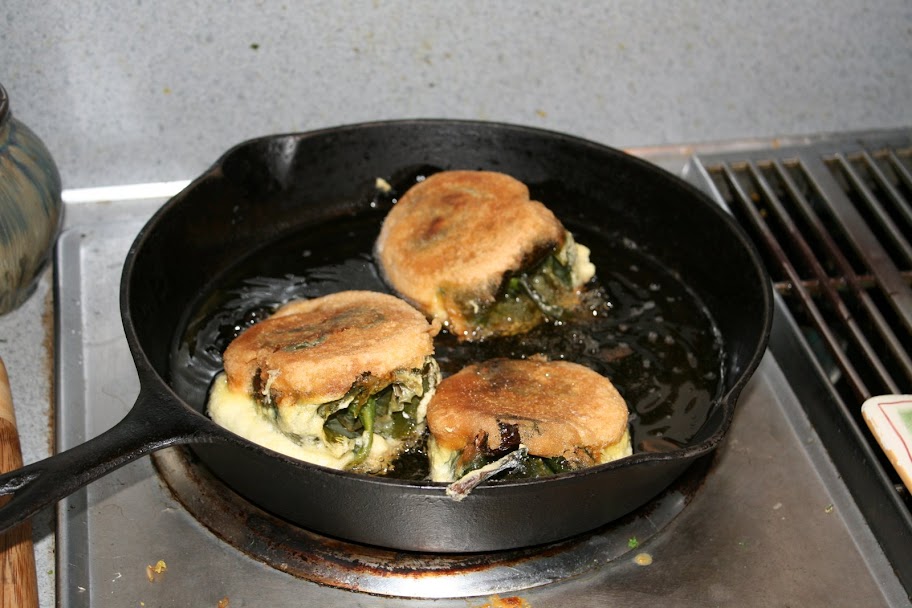
Results:

Oh, and it was really really good.
Monday, August 25, 2008
The big food budget debate
Yep.
Sunday, July 20, 2008
Pasta with bell peppers, bacon, and kale
In a very large saute pan cook the bacon (chopped before into small peices) until crispy.
Sunday, June 29, 2008
Lemon Tahini Dressing
Thursday, May 15, 2008
Books to look into
Emergency Food Storage and Survival Handbook by Peggy Dianne Layton
Encyclopedia for Country Living by the late Carla Emery
The Complete Tightwad Gazette by Amy Dycyzen. (Her last name sounds like 'decision')
These are three books that will really spell it out for you in very easy terms how to live as frugally as possible. Which is usually the best for the planet as well. :)
Wednesday, April 16, 2008
Farewell, My Subaru
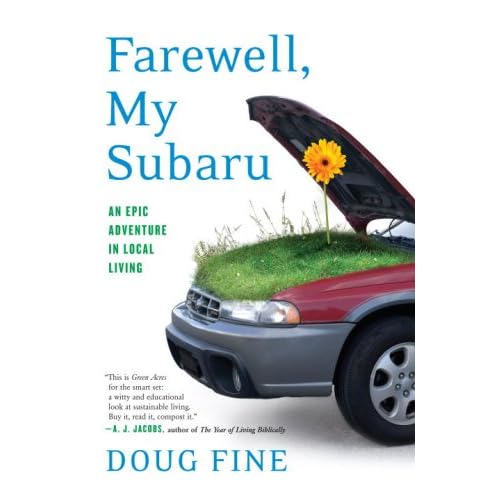 This book was much needed in my life right now. A mix of wonderful writing, humor, and information that I found completely delightful. I read it in three days (and you all know I am a busy woman) and enjoyed 95% of it. The rest, I didn't understand... lol. His quips and comparisons (like naming his local coyote "Dick Cheney") were a highlight for sure. But the trials he went through were also very informative. I learned things I had never understood before. Including information about converting a huge diesel truck (he calls the ROAT or Ridiculously Oversized American Truck) to biofuel, the oily dog situations that ensue on one's property, and the complications that can arise from your ROAT always smelling like KFC, to the intricate measures one has to take to feed livestock newly bought during a devastating flood, his life on Funky Butte Ranch was enlightening, and highly entertaining.
This book was much needed in my life right now. A mix of wonderful writing, humor, and information that I found completely delightful. I read it in three days (and you all know I am a busy woman) and enjoyed 95% of it. The rest, I didn't understand... lol. His quips and comparisons (like naming his local coyote "Dick Cheney") were a highlight for sure. But the trials he went through were also very informative. I learned things I had never understood before. Including information about converting a huge diesel truck (he calls the ROAT or Ridiculously Oversized American Truck) to biofuel, the oily dog situations that ensue on one's property, and the complications that can arise from your ROAT always smelling like KFC, to the intricate measures one has to take to feed livestock newly bought during a devastating flood, his life on Funky Butte Ranch was enlightening, and highly entertaining. Monday, April 14, 2008
Low carb becoming mandatory?
http://www.dailygazette.com/news/2008/feb/29/0229_wheat/
http://www.barternews.com/pdf/WheatShortage.pdf
Aside from people complaining about price, there is a real issue going on with a virus effecting the production of wheat.
Some say the 'shortage' is a myth, talking about the fact that it is really the falling American dollar that is causing the high price. This may be partially true. But with the wheat disease effecting millions in Asia and the Middle East, I think they are wrong. It isn't long before many people with be on mandatory low carbohydrate diets. And some may very well die from the lack.
Even my own local bakery, which we visited yesterday, had a sign up saying "Due to the rising wheat costs, some of our prices may have gone up. We are sorry for the inconveniences this may cause." Before long, bread could be the most expensive item we pick up at the grocery.
Tuesday, April 1, 2008
Find it hard to find coupons for organics?
To answer another question...
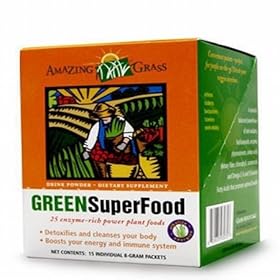
Thursday, March 27, 2008
Did you know?
This is where money outweighs facts when it comes to food marketing. They say that milk does your body good, but in truth, over consumption of milk causes all sorts of problems, and many shouldn't drink the stuff after the age of 4 years old at all! (Between 30 and 50 million Americans are lactose intolerant.)
Amazing what the media can put into our heads that make us put things into our bodies.
Monday, March 24, 2008
Country Capitan Chicken
 This is a recipe that we loved from Kitchen Muse. It is a southern flare dish, with a bit of curry in it that brings out the flavor of everything. It is very nice over brown rice, or couscous. I always side it with a green salad, but you can honestly side it with any veggie dish, or make it a one pot meal by adding in 1 1/2 cups of couscous right into the pot! (We have done this too... it was a hit, but Don likes to pour his sauce over his starch).
This is a recipe that we loved from Kitchen Muse. It is a southern flare dish, with a bit of curry in it that brings out the flavor of everything. It is very nice over brown rice, or couscous. I always side it with a green salad, but you can honestly side it with any veggie dish, or make it a one pot meal by adding in 1 1/2 cups of couscous right into the pot! (We have done this too... it was a hit, but Don likes to pour his sauce over his starch).Country Capitan Chicken
4 Tbs butter
1/2 diced onion
1 diced carrot
1 diced bell pepper (color doesn't matter, but green works best)
6 cloves garlic (minced)
~~~~
3 lbs chicken peices (I like theighs)
2 Tbs olive oil
1/2 c flour
salt and pepper to taste
~~~~
2 cups diced tomatoes
2 cups chicken broth
3 tea curry powder
1/4 c slivered almonds
1/4 cup golden raisins
Melt butter in a large skillet. The skillet should be large ebough to cook the chicken in one layer. Add the onion, carrot, pepper, and garlic and cook until tender. Transfer to a bowl.
Mix flour and salt and pepper in a large bowl. Roll chicken peices in the flour mixture. Put oil into the skillet you just pulled the veggies from, and add the chicken, in one layer, turning until well brown on both sides.
Add veggies back in, along with tomatoes, stock and curry, mixing well. Stir in raisins and almonds. Simmer for about 10 minutes or until all chicken is cook through well.
Serve over couscous or brown rice.
It is very good!
Sunday, March 23, 2008
Wonderful Interviews
http://cookingupastory.com/food-news-michael-pollan-in-defense-of-food/
There are at least 4 interviews here. One is from a farmer from Portland OR with a egg coop that I found yesterday, and it is here as well, and then the interview with Micheal Pollen that is just fasinating. Enjoy!
Wednesday, March 19, 2008
Big Farms vs Small Farms
In contrast, organic farming often utilizes intercropping, crop rotation, fallow periods, and integrated pest management to promote biodiversity and preserve the health of the soil while minimizing the risk of diseases. The main goal of organic farming is sustainability, so organic farms seek to minimize dependence on outside resources and be self-sufficient.
Monday, March 17, 2008
Good article about nutrition, taste, local, and organics
Thursday, March 13, 2008
Animal, Vegetable, Miracle

Tuesday, March 11, 2008
Chocolate chip pumpkin bread
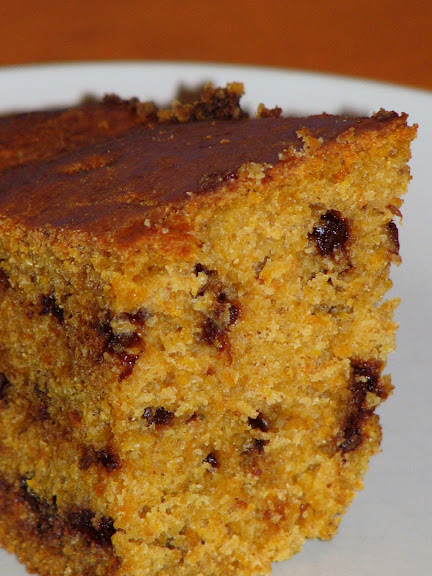 My whole family is in love with pumpkin bread. This is a great recipe, being a bit more dense, and a bit less sweet than most, so the mini simi sweet chips really stand out and give it an amazing flavor. The recipe came about when I had less of some ingredients than I needed for a pumpkin cupcake recipe and went ahead anyway. I am so very glad I did.
My whole family is in love with pumpkin bread. This is a great recipe, being a bit more dense, and a bit less sweet than most, so the mini simi sweet chips really stand out and give it an amazing flavor. The recipe came about when I had less of some ingredients than I needed for a pumpkin cupcake recipe and went ahead anyway. I am so very glad I did.1/2 c vegetable oil
1/4 c water
1 c sugar (raw works fine)
1/2 tsp ground nutmeg
1/2 tsp all spice
1 1/2 tsp baking soda
1/2 tsp salt
Mix 'wet' list together in a large mixing bowl. Beat together until well blended and smooth.
Mix dry together by sifting into another bowl, stir and then add to wet mixture. When well blended, mix in 1/2 c of mini simisweet chocolate chips.
Add batter to a well oiled baking dish (or 24 muffin tins with paper cups), and place in a 375* oven for 45 - 60 minutes.
As with all quick breads, these are done when tooth pick inserted in the center comes out clean.
Cool at least half way before you dig in.... I have gotten a couple burns that way.
Saturday, March 1, 2008
Sustainable Living For Dummies

Thursday, February 28, 2008
HFCS
The process by which HFCS is produced was first developed by Richard O. Marshall and Earl R. Kooi in 1957[2] and refined by Japanese researchers in the 1970s. HFCS was rapidly introduced in many processed foods and soft drinks in the US over the period of about 1975–1985.
First post
Monday, January 14, 2008
Living The Good Life
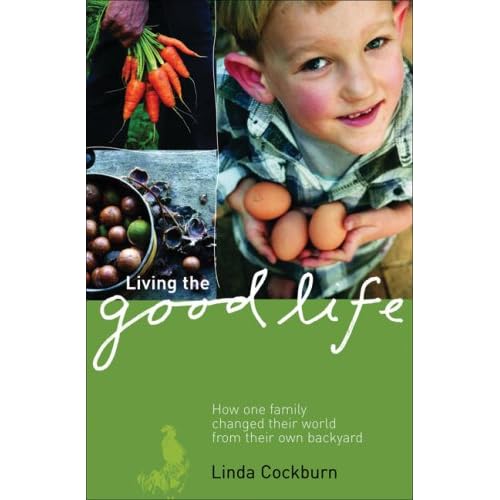 Yet another book about the ethics of food, (and this one also goes into the ethics of energy, water, and even waste disposal).
Yet another book about the ethics of food, (and this one also goes into the ethics of energy, water, and even waste disposal).The Omnivore's Dilemma

Man, the book is SO interesting. Really good information, put out in a way that is matter of fact, and not alarming in the slightest (unless of course, the content is alarming... I think I meant not "alarmist" in the sense that he doesn't go "This is TERRIBLE, look what THEY do....." KWIM?) He goes through four different meals, from as industrial as you can get to as 'natural' as you can get. McDonald's of course, came first. Then Whole Foods industrial organics. Then PolyFace Farms (a sustainable grass/meat farm). Then a meal he hunts, kills, grows or gathers himself.
He follows each one back to the very start of the food chain on which they were formed.
For McDonald's it was industrial grown corn to feed the chickens and the beef (cows are not made to eat corn). It is pretty amazing how much of the fast food is made from corn. You'd never know from eating it, but really, it is all corn fed meat, fried in corn oil, battered in corn starch, corn fats, and salts from corn, with a side of High Fructose Corn Syrup soda. I had some idea, but I just didn't realize how true his most famous quote is: "So that's us; processed corn, walking."
He follows that up with a nice stint on an industrial organic farm. Then moves on to PolyFace, then on to his own hunting/mushroom hunting/gardening experiences.
Fascinating. Just really really interesting stuff.
He makes a point of staying very objective through out the entire book, and sharing his opinions in a language that it is clear he is owning each and every one of them. He doesn't expect you to think the way he does... he just says what HE thinks. It is a nice refresher for those of us who have read "fad" diet books where there is only ONE way to do things (and here is why - and here is the science behind it is on page 452 - and here is why everything else is wrong on page 597... lol.).
The other two books I have right now promise to be lighter, and I am ready. Don said to me the other day that I really need to find something that I can read for pleasure. Something that doesn't give me more to work on and worry about at the end of the day. I said that is what NetFlix is for. lol... he wasn't convinced.


